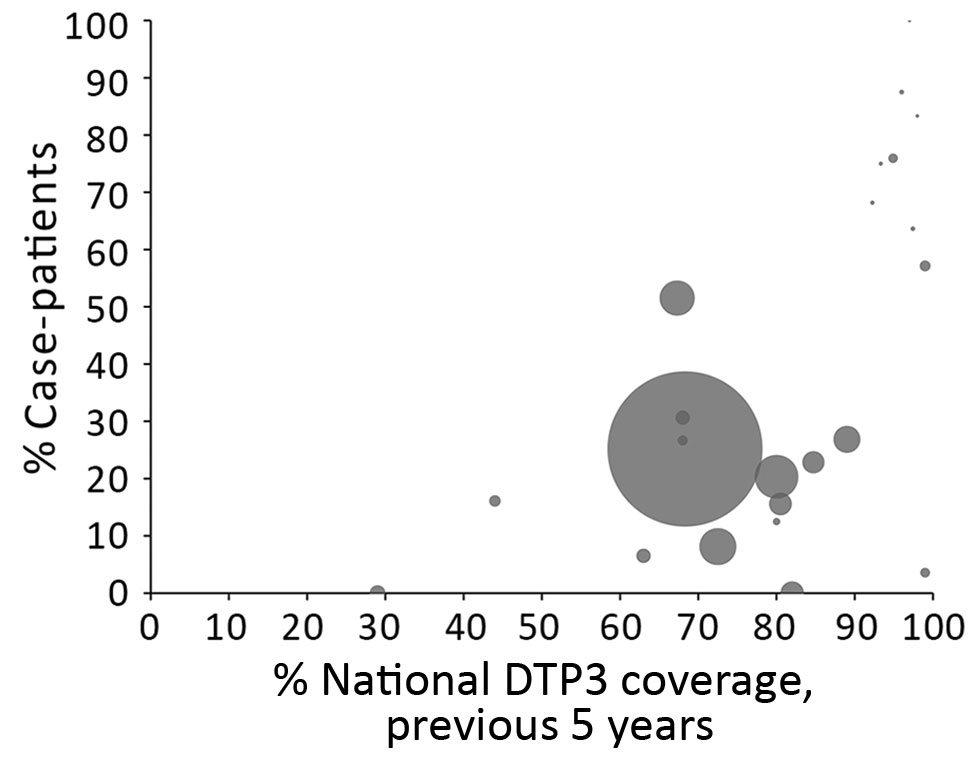Volume 25, Number 10—October 2019
Synopsis
Global Epidemiology of Diphtheria, 2000–20171
Figure 6

Figure 6. Percentage of diphtheria case-patients >15 years of age, by national DTP3 coverage, 2000–2017. Each circle represents a country, and its size is proportionate to the average number of cases reported from the country per year of data in the dataset. The largest data point represents a large number of cases in a single year among Rohingya refugees from Myanmar. The vaccination coverage of the Rohingya population is unknown; therefore, the average of DTP3 coverage of Rakhine State in Myanmar from 2016–2017 was used (18). DTP3, diphtheria–tetanus–pertussis vaccine; UNICEF, United Nations Children’s Fund; WHO, World Health Organization.
References
- Zakikhany K, Efstratiou A. Diphtheria in Europe: current problems and new challenges. Future Microbiol. 2012;7:595–607. DOIPubMedGoogle Scholar
- World Health Organization. World Health Organization expanded programme on immunization. WHA2757. Geneva. Organization. 1974;•••:28–9.
- Galazka A. Implications of the diphtheria epidemic in the Former Soviet Union for immunization programs. J Infect Dis. 2000;181(Suppl 1):S244–8. DOIPubMedGoogle Scholar
- Galazka A. The changing epidemiology of diphtheria in the vaccine era. J Infect Dis. 2000;181(Suppl 1):S2–9. DOIPubMedGoogle Scholar
- Golaz A, Hardy IR, Strebel P, Bisgard KM, Vitek C, Popovic T, et al. Epidemic diphtheria in the Newly Independent States of the Former Soviet Union: implications for diphtheria control in the United States. J Infect Dis. 2000;181(Suppl 1):S237–43. DOIPubMedGoogle Scholar
- Dravid MN, Joshi SA. Resurgence of diphtheria in Malegaon & Dhule regions of north Maharashtra. Indian J Med Res. 2008;127:616–7.PubMedGoogle Scholar
- Landazabal García N, Burgos Rodríguez MM, Pastor D. Diphtheria outbreak in Cali, Colombia, August-October 2000. Epidemiol Bull. 2001;22:13–5.PubMedGoogle Scholar
- Dandinarasaiah M, Vikram BK, Krishnamurthy N, Chetan AC, Jain A. Diphtheria re-emergence: problems faced by developing countries. Indian J Otolaryngol Head Neck Surg. 2013;65:314–8. DOIPubMedGoogle Scholar
- World Health Organization. JRF supplementary questionnaire on surveillance. Geneva: The Organization; 2018 [cited 2018 Oct 20]. https://www.who.int/immunization/monitoring_surveillance/burden/vpd/JRF_Supplementary_Questionnaire_Surveillance_18Mar.pdf
- World Health Organization. Reported immunization schedules by vaccine. Geneva: The Organization; 2018 [cited 2018 Oct 20]. http://www.who.int/immunization/monitoring_surveillance/data
- European Centre for Disease Prevention and Control. Vaccine Scheduler: vaccine schedules in all countries of the European Union. Stockholm: The Centre; 2018 [cited 2018 Oct 20]. https://vaccine-schedule.ecdc.europa.eu
- World Health Organization. Immunization provided at school. Geneva: The Organization; 2017 [cited 2018 Oct 20]. http://www.who.int/immunization/monitoring_surveillance/data
- World Health Organization. Reported estimates of DTP4 coverage. Geneva: The Organization; 2018 [cited 2018 Aug 29]. http://apps.who.int/immunization_monitoring/globalsummary/timeseries/tscoveragedtp4.html
- World Health Organization. Diphtheria vaccine: WHO position paper—August 2017. Geneva: The Organization; 2017 [cited 2019 Jul 16]. https://www.who.int/immunization/policy/position_papers/diphtheria
- World Health Organization. Tetanus vaccines: WHO position pape—February 2017. Geneva: The Organization, 2017 [cited 2019 Jul 16]. https://www.who.int/immunization/policy/position_papers/tetanus
- World Health Organization. WHO–UNICEF estimates of DTP3 coverage 1980–2017. Geneva: The Organization; 2018 [cited 2018 Oct 20]. http://apps.who.int/immunization_monitoring/globalsummary/timeseries/tswucoveragedtp3.html
- MacNeil A, Dietz V, Cherian T. Vaccine preventable diseases: time to re-examine global surveillance data? Vaccine. 2014;32:2315–20. DOIPubMedGoogle Scholar
- Bahl S, editor. Diphtheria outbreak response—Cox’s Bazar, Bangladesh. World Health Organization Strategic Advisory Group of Experts. Geneva: The Organization; 2018 [cited 2019 Jul 16]. http://www.searo.who.int/bangladesh/reportdiph
- Hadler SC, Acosta A, Tiwari T, Patel M, editors. Diphtheria: a re-emerging threat in countries affected by conflict, migration, and social disruption. Atlanta: Emory University; 2019.
- European Centre for Disease Prevention and Control. Gap analysis on securing diphtheria diagnostic capacity and diphtheria antitoxin availability in the EU/EEA. Stockholm: The Centre; July 2017 [cited 2019 May 21]. https://ecdc.europa.eu/en/publications-data/gap-analysis-securing-diphtheria-diagnostic-capacity-and-diphtheria-antitoxin
- World Health organization. WHO–recommended standards for surveillance of selected vaccine-preventable diseases. Geneva: The Organization; 2014. p. 10–2 [cited 2018 Oct 20]. https://www.who.int/immunization/monitoring_surveillance/burden/vpd/WHO_SurveillanceVaccinePreventable_04_Diphtheria_R2.pdf
- Larson HJ, de Figueiredo A, Xiahong Z, Schulz WS, Verger P, Johnston IG, et al. The state of vaccine confidence 2016: global insights through a 67-country survey. EBioMedicine. 2016;12:295–301. DOIPubMedGoogle Scholar
- VanderEnde K, Gacic-Dobo M, Diallo MS, Conklin LM, Wallace AS. Global routine vaccination coverage—2017. MMWR Morb Mortal Wkly Rep. 2018;67:1261–4. DOIPubMedGoogle Scholar
- Gavi. Gavi board starts framing alliance’s approach to 2021–2025 period. Geneva: Gavi; 2018 [cited 2018 Nov 29]. https://www.gavi.org/library/news/press-releases/2018/gavi-board-starts-framing-alliance-s-approach-to-2021-2025-period
- Durrheim DN, Crowcroft NS, Strebel PM. Measles - The epidemiology of elimination. Vaccine. 2014;32:6880–3. DOIPubMedGoogle Scholar
1Preliminary results from this study were presented at the meeting of the Strategic Advisory Group of Experts on Immunization, Geneva, Switzerland, April 25–27, 2017.
2Retired.